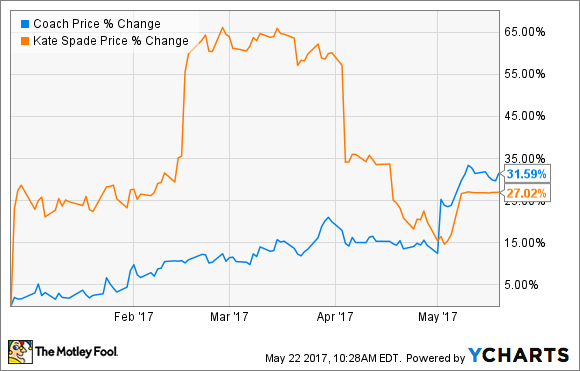After months of rumors that a deal was in the works, Coach (TPR 1.74%) announced this month week that it would be acquiring rival Kate Spade (KATE) for a total of $2.4 billion. The combination of the two companies has the potential to lend a helping hand to the fashion business here in the U.S. and introduce the rest of the world to a new brand.

Image source: Getty Images.
Two major brands under one roof
Coach is paying $18.50 per share in cash to Kate Spade shareholders, a 27.5% premium to trading levels from the final days of 2016 when rumors of a company sale first made headlines.

Data by YCharts.
Shares of Coach also jumped when the news broke. Investors were optimistic about the transaction as Kate Spade has continued to deliver growth over the last few years, driven by the company's popularity with the young but sizable millennial demographic.

Data by YCharts.
At the buyout price, Coach will pay about 20 times expected one-year profitability, not exactly a cheap bid. However, Coach itself fetched a similar valuation with forward price-to-earnings at 19 just prior to the deal announcement. Management expects the deal to be accretive to profitability starting next year with double-digit bottom line growth by 2019.
Part of the rationale is that Kate Spade has little presence outside of the U.S., something Coach believes it can help the brand tackle. Selling American fashion overseas has been a key area of expansion for many companies in the industry as foreign consumers try to get a taste of the "American dream". In the last reported quarter, Kate Spade's international sales were 18% of revenue, compared to 43% at Coach.
Eliminating the competition
Industry followers know it has been tough for apparel retailers and department stores recently. Sales growth has slowed as shoppers become more frugal and head online to look for deals. For many in the industry, heavy discounting has been a means to keep shoppers' interest, but that can be a double-edged sword.

Image source: Kate Spade.
Cutting prices on merchandise has kept sales from a full-on slide but not so for profitability. Besides the obvious problems discounting has on the bottom line, it also becomes a self-perpetuating cycle -- shoppers become trained to wait for discounts before purchasing. It also diminishes brand loyalty and value, a significnat long-term risk for a fashion company. What fashion designer ever wants to hear, "I bought this handbag, because it was cheap?"
Coach had been grappling with this problem but has begun to show signs of recovery with sales and profits on the mend. Its solution? Cutting back on cutting back. Promotional sales have been reduced, and the company has also pulled out of some department stores, notorious for pushing the discount event.
Bringing Kate Spade into the fold eliminates a competitor undercutting prices and gives Coach the opportunity to help Kate Spade avoid the same pitfalls. The deal could ultimately end up being good for the whole industry.
Fashion as art and art as profit
Selling "art" as a public, for-profit company is an unenviable task -- just ask the fashion industry. Growing the top and bottom lines for shareholders is a balancing act, but Coach's latest efforts appear to be gaining traction.
Now, with two major brands under the same roof, the company can shore up its U.S. operations and look abroad for additional growth.





